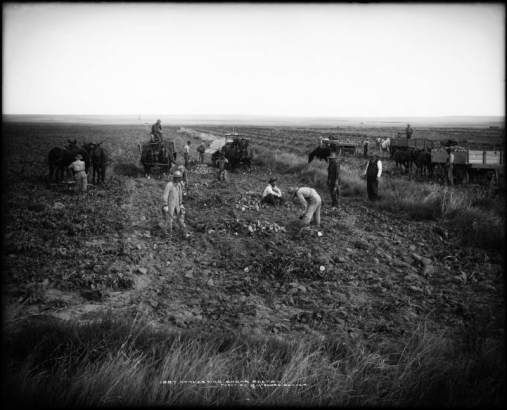Western History library staff hear many personal stories from our patrons as we help them search for evidence documenting the many twists and turns of history. Often, questions that appear to be about one thing develop into a different topic entirely. In the case we’re about to discuss, a query that at first seemed to be an academic research project turned out to be a very personal story of a family impacted by larger historical events. This post is the first of a new series sharing reference questions that unfolded into a greater picture.
Our researchers come from many different angles—academics working on books, journalists illustrating stories, genealogists seeking missing pieces—so you never quite know the background behind a question. With more complex requests the email interaction may take a few rounds until we have satisfied the customer’s need, and sometimes we form a working friendship through the process.
At the beginning of the COVID-19 pandemic, we received a query about migrant workers coming from Mexico to Colorado in the 1910s-1930s. It was similar in tone to requests we receive from academic researchers and authors.
As this particular reference interview developed, a remarkable story fleshed out. Our researcher, Martin*, lives in New York City. We began corresponding while New York was under lockdown due to the pandemic. While missing his annual road trip to New England for lobster and blueberry pie, he was making good use of this time to work on his genealogy and writing projects.
Martin was born in Denver in the mid-1940s to agricultural workers who had first come to Colorado from Mexico in 1919. Repeated and temporary migration for seasonal farmwork was common in that era, most often followed by a return to Mexico during the off-season. This practice, and the economics that made it necessary, resulted in temporary family separations that sometimes produced painful impacts on families, much as we see it can today.
Martin believes his father came to the United States for work several times over the years. Shortly after his birth in Denver, his mother placed him in the Colorado State Home for Dependent and Neglected Children, for unknown reasons. His stay in the home was brief: a young Denver couple adopted him, and his life thereafter pursued a different path. As an adult, Martin has served the global community through a wide-reaching career in international humanitarian aid. Recently, he learned the identity of his birth parents through DNA research, and he has been tracing his family story since.
When he contacted us, Martin had already located a fair amount of information about his birth family via Ancestry, including his father’s 1919 work visa, a recorded entry through Texas, a photograph, and census information. We helped him locate his father’s 1990 obituary in the Rocky Mountain News, and information on the children's home where he briefly lived, including a manuscript collection, and other primary source materials. We have worked with him to build a bibliography of materials he will want to visit and review in our reading room, when life returns to normalcy.
As we were not able to find additional information on his father specifically, we have turned to collections that give Martin an understanding of what his birth family’s lives might have been like. This is something genealogists do a lot: help researchers understand the past by highlighting historical movements that possibly could have shaped their ancestors' actions. The items we located for Martin range from the manuscript collections of agricultural laborers of Mexican descent, to information on sugar beet workers (one of the Colorado crops that brought many agricultural laborers here), to books about Mexican return migration and the Hispanic community in Colorado during the first half of the 20th century. These materials have allowed him to possibly see the world through their eyes, and to understand more about the context of his earliest days of life.
As Martin’s journey with this research continues, new technologies, new research collections, or simple serendipity could add to discoveries about his origins at any time. Whether he chooses to write a book, contact remaining descendants of his birth parents, or simply sit quietly with what he has learned is up to him.
Whatever his decision, this story illustrates that genealogy research is a wonderful tool for finding your identity where the curtains of history have obscured it. It is about reclaiming the stories of our ancestors from the past, especially when the lives they lived were not well documented because of their national origin, ethnicity, or lack of wealth or power.
We librarians don’t always know what happens after our work with a customer, but we have been happy to assist Martin in his search. We continue to serve our library customers by email and phone during our closure, but we look forward to seeing Martin (and all of you) at the library in the future!
---------------------------------
*We have changed our researcher’s name to protect his privacy, and obtained his permission to share this story prior to posting.





Comments
This is a great example of
This is a great example of the many different kinds of family stories you help people track down. So fascinating. Thanks for sharing. Can’t wait to be able to visit in person again next year!
Thanks for your comment! It's
Thanks for your comment! It's also a perk of a librarian's job: hearing interesting stories and helping people make meaningful connections. We can't wait to see you all again next year as well!
Add new comment